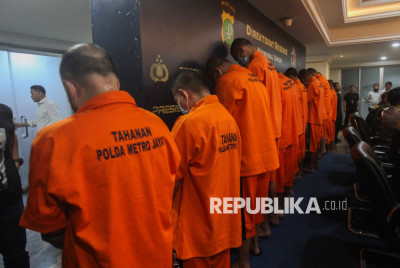August 5, 2025 | 11:02 am

Avivah Yamani, an astronomy enthusiast from the South Sky community in Bandung, said that several celestial events are set to occur in August 2025. "There will be the Perseid meteor shower and the Jupiter-Venus conjunction," she said on Sunday, August 3, 2025.
The Jupiter and Venus conjunction is expected to be visible from Earth on August 12th. This celestial phenomenon can be observed in the eastern sky, and observers will have to wait for Venus to rise in the early morning, predicted to occur at 03:13 AM WIB (Western Indonesian Time).
What is the Perseid Meteor Shower?
The peak of the Perseid meteor shower is expected on the night of August 12th to the early morning of August 13th, 2025. This phenomenon starts from mid-July and will end in August. It originates from the debris and ice left by the Swift-Tuttle Comet as the Earth crosses its path.
When small fragments the size of a grain of sand enter the atmosphere at a speed of 214,000 kilometers per hour, they will burn and appear as bright flashes of light in the sky. Most meteors are visible at an altitude of about 97 kilometers and reach temperatures of over 1,650 degrees Celsius.
According to the NASA website, this year's Perseid meteor shower will appear faster and brighter. Perseid will leave long-lasting trails of light and colors as it crosses the Earth's atmosphere.
Perseid is a meteor shower with about 50 to 100 meteors visible per hour. This meteor shower occurs during warm summer nights. However, this year, the meteor shower coincides with the full moon phase, which may reduce visibility of the faint meteors.
Perseid appears as a fireball originating from a brighter flash of light and color that can last longer than a typical meteor streak. This advantage is due to the fireball originating from larger comet material particles.
Meteors originate from the remnants of comet particles and asteroid fragments. When a comet orbits the Sun, it leaves a trail of dust behind. Every year, the Earth passes through this debris trail, allowing these fragments to collide with the atmosphere. The fragments that collide with the atmosphere will disintegrate, forming glowing and colorful streaks in the sky.
The space debris pieces that interact with the Earth's atmosphere to form the Perseid originate from the 109P/Swift-Tuttle comet. Swift-Tuttle comet orbits the Sun once every 133 years. The Swift-Tuttle comet was discovered in 1862 by Lewis Swift and Horace Tuttle. In 1865, Giovanni Schiaparelli first observed scientifically that this comet is the cause of the Perseid.
Swift-Tuttle is a large comet with a nucleus diameter of 26 kilometers. The Swift-Tuttle comet approached the Earth in 1992 and will cross again in 2126. The name Perseid is taken from the radiant, the point in the sky where the Perseid appears to originate, namely the Perseid constellation. The constellation, which gives its name to the meteor shower, only serves to help observers determine which meteor shower is observed on a particular night. However, the constellation is not the source of the meteor.
Anwar Siswadi and Rachel Caroline L. Toruan contributed to the writing of this article.
Editor's Choice: Bandung Regency and BRIN Collaborate to Develop Astrotourism
Click here to get the latest news updates from Tempo on Google News
Today's Top 3 News: Indonesian Police Showcase Humanoid Robot on Their 79th Anniversary
34 hari lalu

Here is the list of the top 3 news on Tempo English today.
Astronomy Professor Criticizes Global Hijri Calendar, Muhammadiyah Responds
36 hari lalu

Professor of astronomy and astrophysics from the National Research and Innovation Agency (BRIN), Thomas Djamaluddin, has criticized the Global Hijri Calendar as it has the potential to create more discrepancies in Indonesia.
Top 12 Darkest Places in the US for Spectacular Night Sky Views
37 hari lalu

See the darkest places in the U.S. here that can transform your nighttime experience into something truly magical.
Today's Top 3 News: Prabowo to Meet Capital Market Investors After Eid
2 April 2025

Here is the list of the top 3 news on Tempo English today.
Bandung Regency and BRIN Collaborate to Develop Astrotourism
17 Maret 2025

The Regency of Bandung aims to explore the visual aesthetics of the night sky as a tourist activity, for instance, capturing the image of the Milky Way galaxy.
When and Where to See the Quadrantid Meteor Shower in January 2025
2 Januari 2025

The New Year arrives with a meteor shower in January, the Quadrantids. Find out when and where to see the Quadrantid meteor shower here!
Solar Storms Peak to Continue Until 2025, May Disrupt Communication and Satellites
9 Desember 2024

BRIN Expert Researcher in Astronomy recalled that the largest solar storm to hit Earth, known as the Carrington Flare, occurred in 1859.
Happening in the Sky This Month: Planetary Conjunction, Solstice, and 120 Meteors Per Hour Rainout
4 Desember 2024

Several astronomical phenomena will color the sky throughout December 2024. One of the spectacular events is the Geminid meteor shower.
7 Best Places to Stargaze in the World, View the Cosmic Views
22 November 2024

From Utah to Nepal, this article explores the seven best places to stargaze in the world which provide the perfect canvas for the astronomical marvels
9 Countries Celebrating Independence Day in August, Indonesia Included
15 Agustus 2024

Explore the list of countries celebrating their Independence Day in August, including Indonesia, with historical insights and national pride.
















































